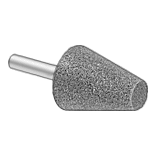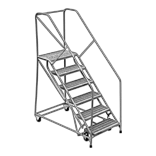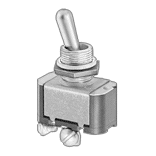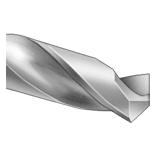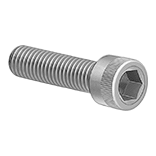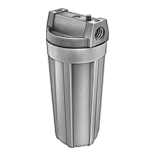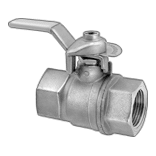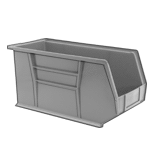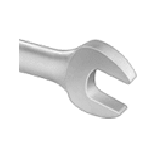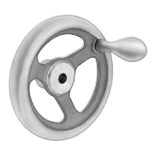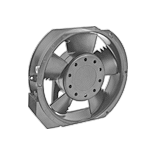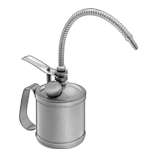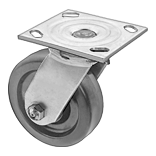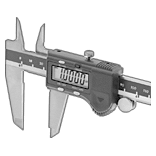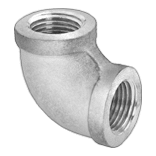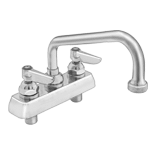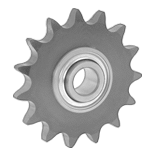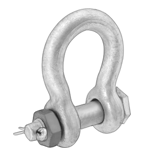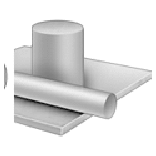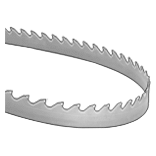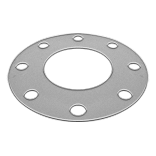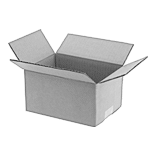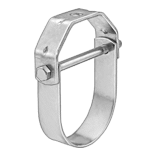About Timer Relays
More
Choosing an Electrical Switch
More
Compact Spade-Terminal Relays


Fit these relays where standard spade-terminal relays are too big. You can connect them three ways. Plug them into a socket (sold separately), connect them with quick-disconnect terminals, or solder wires directly to the terminals. An LED indicator shows you the status of the relay, so you know it’s connected and wired correctly.
Relays that control 2 or more circuits have a lockable test button, so you can test their function. When you press the button, the relay switches contacts. Use this button when checking a relay for proper function before installing it, or when investigating issues with wired relays.
Relay sockets mount directly on 35 mm DIN rail (also known as DIN 3 rail) for fast installation. You can also mount them to a flat surface using screws.
For technical drawings and 3-D models, click on a part number.
Relays | Relay Sockets with Screw Terminals | |||||||||||
|---|---|---|---|---|---|---|---|---|---|---|---|---|
| Number of Terminals | Input Voltage | Control Current, mA | Switching Current @ Voltage | Maximum Switching Voltage | Ht. | Wd. | Dp. | Quick-Disconnect Tab Wd. | Each | Each | ||
4 Circuits Controlled with 4 Off (Normally Open) or 4 On (Normally Closed)—4PDT | ||||||||||||
Relay-Socket Mount | ||||||||||||
| 14 | 24V AC | 50 | 8 A @ 120 V AC/24 V DC | 300V AC | 1.1" | 0.9" | 1.6" | 0.11" | 000000000 | 000000 | 0000000 | 000000 |
| 14 | 120V AC | 10 | 8 A @ 120 V AC/24 V DC | 300V AC | 1.1" | 0.9" | 1.6" | 0.11" | 000000000 | 00000 | 0000000 | 00000 |
| 14 | 240V AC | 5 | 8 A @ 120 V AC/24 V DC | 300V AC | 1.1" | 0.9" | 1.6" | 0.11" | 000000000 | 00000 | 0000000 | 00000 |
| 14 | 12V DC | 92 | 8 A @ 120 V AC/24 V DC | 300V AC | 1.1" | 0.9" | 1.6" | 0.11" | 000000000 | 00000 | 0000000 | 00000 |
| 14 | 24V DC | 46 | 8 A @ 120 V AC/24 V DC | 300V AC | 1.1" | 0.9" | 1.6" | 0.11" | 000000000 | 00000 | 0000000 | 00000 |
DIN-Rail Mount Interface Relays

Isolate input and output circuits to prevent damage from voltage spikes, reduce signal interference, and amplify signal. These relays interface between your controller and components—they receive a signal from the controller to switch power on or off to the components. All have an LED indicator that shows you if your switch is actuated, so you know it’s connected and wired correctly. Use them to communicate signals to devices like motors or sensors. Mount them on 35 mm DIN rail (also known as DIN 3 rail).
Relays with PLC output protection prevent voltage spikes created by the relay from damaging the output channel on your programmable logic controller (PLC).
For technical drawings and 3-D models, click on a part number.
Relays with Relay Sockets | Replacement Relays | |||||||||||
|---|---|---|---|---|---|---|---|---|---|---|---|---|
| Number of Terminals | Input Voltage | Control Current, mA | Switching Current @ 240V AC | hp @ Switching Voltage | Ht. | Wd. | Dp. | Features | Each | Each | ||
2 Circuits Controlled with 2 Off (Normally Open) or 2 On (Normally Closed)—DPDT | ||||||||||||
With Screw Terminals | ||||||||||||
| 8 | 24V AC | 45 | 8A | 1/4 hp @ 120 V AC | 3.3" | 0.6" | 2.7" | LED Indicator, PLC Output Protection | 0000000 | 000000 | 0000000 | 000000 |
| 8 | 120V AC | 8 | 8A | 1/4 hp @ 120 V AC | 3.3" | 0.6" | 2.7" | LED Indicator, PLC Output Protection | 0000000 | 00000 | 0000000 | 00000 |
| 8 | 120V AC, 120V DC | 4.5 | 8A | 1/2 hp @ 120 V AC | 3.5" | 0.6" | 3" | LED Indicator | 0000000 | 00000 | 0000000 | 0000 |
| 8 | 240V AC, 240V DC | 5 | 8A | 1/2 hp @ 120 V AC | 3.5" | 0.6" | 3" | LED Indicator | 0000000 | 00000 | 0000000 | 0000 |
| 8 | 24V DC | 20 | 8A | 1/4 hp @ 120 V AC | 3.3" | 0.6" | 2.7" | LED Indicator, PLC Output Protection | 0000000 | 00000 | 0000000 | 0000 |
DIN-Rail Mount Solid State Relays
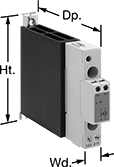
Unlike mechanical relays, these solid state relays have no moving parts, so they require less maintenance and last longer, switch faster, and are quieter. They mount on 35 mm DIN rail (also known as DIN 3) for fast installation. An LED indicator lights up when these relays are connected, so you can quickly confirm that they’re wired correctly. IP20 rated, their terminals are recessed, so they prevent fingers and other objects from touching live circuits.
Relays with an integrated heat sink disperse heat to increase the relay’s current rating.
For technical drawings and 3-D models, click on a part number.
| Number of Terminals | Input Voltage | Control Current, mA | Switching Current @ Voltage (Load Type) | Max. Switching Voltage | Ht. | Wd. | Dp. | Features | Each | |
1 Circuit Controlled with 1 Off (Normally Open)—SPST-NO | ||||||||||
|---|---|---|---|---|---|---|---|---|---|---|
Single Phase | ||||||||||
| 4 | 3V DC, 6V DC, 12V DC, 24V DC, 30V DC | 30 | 4.5 A @ 24 V AC (Full Load) 8 A @ 24 V AC (Resistive Load) 10 A @ 24 V AC | 600V AC | 3.54" | 0.69" | 2.56" | Integrated Heat Sink, LED Indicator | 0000000 | 0000000 |
| 4 | 4V DC, 6V DC, 12V DC, 24V DC, 30V DC | 12 | 4.5 A @ 24 V AC (Full Load) 8 A @ 24 V AC (Resistive Load) 15 A @ 3 V DC | 50V DC | 3.54" | 0.69" | 2.56" | Integrated Heat Sink, LED Indicator | 0000000 | 000000 |
Circuit Board Relays

Smaller than relays with electrical wiring, these relays fit in compact devices. Mount them through holes on circuit boards with their solder pin terminals. Use them to control heaters, fans, and other high-power components from a low-power circuit.
For technical drawings and 3-D models, click on a part number.
| Number of Terminals | Input Voltage | Control Current, mA | Switching Current @ Voltage | Max. Switching Voltage | Mechanical Life Cycles | Ht. | Wd. | Dp. | Pin Lg. | Each | |
Mechanical | |||||||||||
|---|---|---|---|---|---|---|---|---|---|---|---|
2 Circuits Controlled with 2 Off (Normally Open) or 2 On (Normally Closed)—DPDT | |||||||||||
| 8 | 120V AC | 8.4 | 8 A @ 240 V AC | 250V AC | 10,000,000 | 1.1" | 0.5" | 1" | 0.21" | 0000000 | 00000 |
| 8 | 110V DC | 4.5 | 8 A @ 240 V AC | 250V AC | 10,000,000 | 1.1" | 0.5" | 0.6" | 0.1" | 0000000 | 0000 |
Screw Terminal Relays
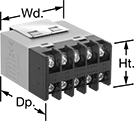

Use the screw terminals to hardwire these relays. The built-in enclosure protects contacts from dust and dirt. These relays accept voltage drops up to 50% of the rated voltage without switching. They’re often used with industrial automation systems, security and emergency lighting, and small motors. Also known as power relays.
Switching Current @ Voltage | |||||||||||
|---|---|---|---|---|---|---|---|---|---|---|---|
| Number of Terminals | Input Voltage | Control Current, mA | Off (Normally Open) Circuit Position | On (Normally Closed) Circuit Position | Maximum Switching Voltage | hp @ Switching Voltage | Ht. | Wd. | Dp. | Each | |
4 Circuits Controlled with 2 Off (Normally Open) and 2 On (Normally Closed)—4PST-2NO/2NC | |||||||||||
| 10 | 120V AC | 22 | 25 A @ 240 V AC/24 V DC | 8 A @ 240 V AC/24 V DC | 250V AC | 1 1/2 hp @ 120 V AC 3 hp @ 240 V AC 3 hp @ 277 V AC | 1.4" | 2" | 2.5" | 0000000 | 000000 |
| 10 | 24V DC | 83 | 25 A @ 240 V AC/24 V DC | 8 A @ 240 V AC/24 V DC | 250V AC | 1 1/2 hp @ 120 V AC 3 hp @ 240 V AC 3 hp @ 277 V AC | 1.4" | 2" | 2.5" | 0000000 | 00000 |
4 Circuits Controlled with 3 Off (Normally Open) and 1 On (Normally Closed)—4PST-3NO/1NC | |||||||||||
| 10 | 120V AC | 22 | 25 A @ 240 V AC/24 V DC | 8 A @ 240 V AC/24 V DC | 250V AC | 1 1/2 hp @ 120 V AC 3 hp @ 240 V AC 3 hp @ 277 V AC | 1.4" | 2" | 2.5" | 0000000 | 00000 |
| 10 | 24V DC | 83 | 25 A @ 240 V AC/24 V DC | 8 A @ 240 V AC/24 V DC | 250V AC | 1 1/2 hp @ 120 V AC 3 hp @ 240 V AC 3 hp @ 277 V AC | 1.4" | 2" | 2.5" | 0000000 | 00000 |
Circuit Board Safety Relays

Reduce connection errors on circuit boards that control machine guards and other safety devices. Also known as force-guided contact relays, they have contact pairs that won’t close at the same time, even if contacts stick or weld shut. These relays take up less space on a board than those with electrical wiring because their solder pin terminals mount directly through circuit board holes. Use them to control high-power components, such as fans and heaters, from a low-power circuit.
For technical drawings and 3-D models, click on a part number.
| Number of Terminals | Input Voltage | Control Current, mA | Switching Current @ Voltage | Max. Switching Voltage | Mechanical Life Cycles | Ht. | Wd. | Dp. | Pin Lg. | Features | Each | |
2 Circuits Controlled with 2 Off (Normally Open) or 2 On (Normally Closed)—DPDT | ||||||||||||
|---|---|---|---|---|---|---|---|---|---|---|---|---|
| 8 | 24V DC | 29 | 8 A @ 240 V AC | 250V AC | 10,000,000 | 1.1" | 0.5" | 1" | 0.2" | Interlocked Opposing Contacts | 0000000 | 000000 |
Interface Safety Relays

These relays pair the transmission reliability of an interface relay with the fail-safe operation of a safety relay. Use them to communicate signals to devices like motors or sensors. They have interlocking contacts—also known as force-guided or mechanically linked contacts—so opposing contacts won't close at the same time. This minimizes the chance of arcing, so electricity won't jump across the contacts and interfere with your relay or system. They also have an interface that isolates input and output circuits to prevent damage from voltage spikes, reduce signal interference, and amplify signal. Mount them on 35 mm DIN rail (also known as DIN 3 rail). The relays disconnect from the socket for quick replacement.
For technical drawings and 3-D models, click on a part number.
Relays | Replacement Relays | |||||||||||||
|---|---|---|---|---|---|---|---|---|---|---|---|---|---|---|
| Number of Terminals | Input Voltage | Control Current, mA | Switching Current @ Voltage | Max. Switching Voltage | hp @ Switching Voltage | Mechanical Life Cycles | Ht. | Wd. | Dp. | Features | Each | Each | ||
2 Circuits Controlled with 2 Off (Normally Open) or 2 On (Normally Closed)—DPDT | ||||||||||||||
| 8 | 24V DC | 29 | 8 A @ 240 V AC | 250V AC | 1/2 hp @ 230 V AC | 10,000,000 | 3.1" | 0.6" | 2.4" | Interlocked Opposing Contacts | 0000000 | 000000 | 0000000 | 000000 |
Hazardous Location Relays

Sealed for safety, these relays are a good choice for hazardous locations where combustible or corrosive gases may be present.
Relays with screw terminals or spring-clamp terminals are considered interface relays, so they’re placed between your controller and components to isolate the input and output circuits. This means they protect your component from voltage spikes while amplifying the relay’s signal and reducing interference for reliable transmission. They are often used for switching applications, such as small motors and pilot lights. The included relay socket mounts on 35 mm DIN rail (also known as DIN 3 rail).
For technical drawings and 3-D models, click on a part number.
| Number of Terminals | Input Voltage | Control Current, mA | Switching Current @ Voltage | Max. Switching Voltage | Ht. | Wd. | Dp. | Environmental Rating | Each | |
Screw Terminals | ||||||||||
|---|---|---|---|---|---|---|---|---|---|---|
2 Circuits Controlled with 2 Off (Normally Open) or 2 On (Normally Closed)—DPDT | ||||||||||
| 8 | 24V AC, 24V DC | 13.5 | 8 A @ 240 V AC/24 V DC | 400V AC/300V DC | 3.5" | 0.6" | 2.9" | IP20; NEC Class I Division 2 Groups A, B, C, D | 0000000 | 000000 |
| 8 | 48V AC, 48V DC | 4 | 8 A @ 240 V AC/24 V DC | 400V AC/300V DC | 3.5" | 0.6" | 2.9" | IP20; NEC Class I Division 2 Groups A, B, C, D | 0000000 | 00000 |
| 8 | 120V AC, 120V DC | 3.5 | 8 A @ 240 V AC/24 V DC | 400V AC/300V DC | 3.5" | 0.6" | 2.9" | IP20; NEC Class I Division 2 Groups A, B, C, D | 0000000 | 00000 |
| 8 | 240V AC, 240V DC | 3.5 | 8 A @ 240 V AC/24 V DC | 400V AC/300V DC | 3.5" | 0.6" | 2.9" | IP20; NEC Class I Division 2 Groups A, B, C, D | 0000000 | 00000 |
Smart Multifunction Monitoring Relays
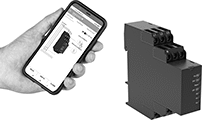
Remotely control these relays through an app on your smartphone—they simultaneously monitor phase, voltage, and frequency. The downloadable app lets you change the tripping range, modify settings, and save programs to apply to multiple relays. Tap your smartphone or tablet to the relays to connect to them. They use NFC (near field communication), so you don’t need to manually pair them like Bluetooth devices.
You’ll often see these relays used to protect motors, generators, and other three-phase circuits from burning out or overheating. They'll switch the circuit off if they detect voltage or frequencies outside of the set range or phase loss, imbalance, or reversal. You can see that they're wired correctly and when they're actuated based on the LED indicators. Rated IP20, they have recessed terminals that keep fingers and other objects from touching live circuits. Mount them on a 35 mm DIN rail (also known as DIN 3 rail) for fast installation.
For technical drawings and 3-D models, click on a part number.
Trip Voltage | Trip Frequency | |||||||||||||||
|---|---|---|---|---|---|---|---|---|---|---|---|---|---|---|---|---|
| Number of Terminals | Input Voltage | Min. | Max. | Input Frequency, Hz | Min., Hz | Max., Hz | Trip Time, sec. | Reset Type | Switching Current @ Voltage | Max. Switching Voltage | Ht. | Wd. | Dp. | Operating System Compatibility | Each | |
2 Circuits Controlled with 2 Off (Normally Open) or 2 On (Normally Closed)—DPDT | ||||||||||||||||
With Screw Terminals | ||||||||||||||||
| 12 | 208V AC, 240V AC, 300V AC, 480V AC | 208V AC | 480V AC | 50, 60 | 45 | 66 | 0.1-60 | Automatic | 8 A @ 240 V AC | 250V AC | 3.5" | 0.9" | 3.9" | Android 7.0 or Later, iOS 14.5 or Later | 0000000 | 0000000 |
Frequency-Monitoring Relays
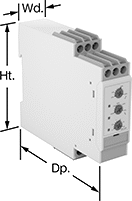
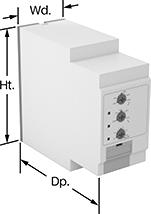
Prevent changes in frequency from damaging sensitive equipment. Often used with motors, fluorescent lighting, and controllers, these relays cut power to your device if the frequency falls outside the set range. Switches on the front of these relays let you set your trip frequency and time. You can see that they're wired correctly and when they're actuated based on the LED indicators. Rated IP20, these relays have recessed terminals that keep fingers and other objects from touching live circuits.
DIN-rail mount relays snap onto 35 mm DIN rail (also known as DIN 3 rail) for fast installation.
Relay-socket mount relays plug into a socket (sold separately), which is required for installation.
For technical drawings and 3-D models, click on a part number.
Relays | ||||||||||||||||
|---|---|---|---|---|---|---|---|---|---|---|---|---|---|---|---|---|
Trip Frequency Setting | Relay Sockets | |||||||||||||||
| No. of Terminals | Input Voltage | 50 Hz Input | 60 Hz Input | Trip Time, sec. | Reset Type | Switching Current @ Voltage | Max. Switching Voltage | Adjustment Style | Ht. | Wd. | Dp. | Features | Each | Each | ||
1 Off (Normally Open) or 1 On (Normally Closed)—SPDT | ||||||||||||||||
DIN-Rail Mount | ||||||||||||||||
| 9 | 24V AC, 48V AC, 120V AC, 240V AC | 40-60 Hz 48-52 Hz | 50-70 Hz 58-62 Hz | 0.1-30 | Automatic, Manual | 8 A @ 240 V AC 5 A @ 24 V DC | 250V AC 24V DC | DIP Switch | 3.1" | 0.9" | 3.9" | LED Indicator | 0000000 | 0000000 | 000000 | 00 |
Relay-Socket Mount | ||||||||||||||||
| 1 | 24V AC, 48V AC, 120V AC, 240V AC | 40-60 Hz 48-52 Hz | 50-70 Hz 58-62 Hz | 0.1-30 | Automatic, Manual | 8 A @ 240 V AC 5 A @ 24 V DC | 250V AC 24V DC | DIP Switch | 3.1" | 1.4" | 3.7" | LED Indicator | 0000000 | 000000 | 0000000 | 000000 |
DIN-Rail Mount Multifunction Timer Relays


Control multiple timing functions from your electrical cabinet—these timer relays mount to 35 mm DIN rail (also known as DIN 3 rail), which is the most commonly used size. UL Listed, C-UL Listed, or CE Marked, these relays meet American, Canadian, or European safety standards.
Timer relays with delayed, interval, switch-on, and repeat cycles have a broad range of applications. Use them to precisely control machines such as conveyors, lighting systems, and electric motors.
For technical drawings and 3-D models, click on a part number.
Delayed Start (Delay-on-Make)—This function allows you to set how long it takes for the relay to turn on after input voltage is applied. For example, a drill starts pumping lubricant immediately, but it does not start rotating until the set time has elapsed.
Delayed Switch-Off (Delay-on-Break)—This function uses a switch instead of input voltage. When the switch is turned off, the relay remains on for a programmed amount of time before turning off. For example, a projector’s light is turned off with a switch, but its cooling fan continues to run for a set time.
Delayed Switch-On with Delayed Switch-Off—This function uses a switch instead of input voltage. It allows you to set how long the relay takes to turn on after a switch is turned on, and how long it will stay on after the switch is turned off. For example, a furnace turns on, but the fan doesn’t start pushing air through the vents until it has been heated. When the furnace turns off, the fan keeps blowing to circulate all the hot air.
Delayed Pulse—This function uses input voltage to turn on the relay for a brief period after a preset time. For example, a light flashes a few seconds after a door closes.
Interval—This function uses input voltage to turn on the relay for a programmed amount of time. For example, when a part moving down a conveyor reaches a certain location, a cleaning spray comes on for a set time.
Interval Switch-Off—This function requires a switch to activate the relay, which stays off for the programmed amount of time. For example, lights in a storage room are turned on with a switch and stay on for a set time before turning off.
Switch-On (Single-Shot)—This function requires a switch to activate the relay, which stays on for the programmed amount of time. For example, lights in a storage room are turned on with a switch and stay on for a set time before turning off.
Repeat Cycle—This function starts with an on cycle and then alternates between an on cycle and off cycle of equal durations until input voltage is removed. A common example would be a flashing light.
Start-Off Repeat Cycle—This function starts with an off cycle and alternates between an on cycle and off cycle of equal durations until input voltage is removed. A common example would be a flashing light.
Switch Fixed On/Off—This function requires a switch to activate the timing function instead of the input voltage (which is applied the entire time). It keeps the relay on whenever the switch is closed; it will only turn off if the switch is open.
Timing Range | ||||||||||||
|---|---|---|---|---|---|---|---|---|---|---|---|---|
| No. of Terminals | Input Voltage | Control Current, mA | Timer Relay Function | No. of | Overall | Switching Current @ 240V AC | Max. Switching Voltage | Ht. | Wd. | Dp. | Each | |
1 Circuit Controlled with 1 Off (Normally Open) or 1 On (Normally Closed)—SPDT | ||||||||||||
| 8 | 12V AC, 24V AC, 48V AC, 120V AC, 240V AC, 12V DC, 24V DC, 48V DC, 60V DC, 120V DC, 240V DC | 6 | Delayed Start (Delay-on-Make) Delayed Switch-Off (Delay-on-Break) Delayed Switch-On with Delayed Switch-Off Delayed Pulse Interval Interval Switch-Off Switch-On (Single-Shot) Repeat Cycle Start-Off Repeat Cycle Switch Fixed On/Off | 8 | 0.1 sec.-10 days | 8A | 250V AC | 4.1" | 0.7" | 2.6" | 00000000 | 000000 |
2 Circuits Controlled with 2 Off (Normally Open) or 2 On (Normally Closed)—DPDT | ||||||||||||
| 8 | 12V AC, 24V AC, 48V AC, 120V AC, 240V AC, 12V DC, 24V DC, 48V DC, 60V DC, 120V DC, 240V DC | 7 | Delayed Start (Delay-on-Make) Delayed Switch-Off (Delay-on-Break) Delayed Switch-On with Delayed Switch-Off Delayed Pulse Interval Interval Switch-Off Switch-On (Single-Shot) Repeat Cycle Start-Off Repeat Cycle Switch Fixed On/Off | 8 | 0.1 sec.-10 days | 8A | 250V AC | 4.1" | 0.7" | 2.6" | 00000000 | 000000 |
Solid State Surface-Mount Timer Relays
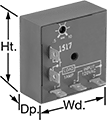
Attach these relays to a flat surface using the mounting hole. They have no moving parts, so compared to mechanical switches, they require less maintenance, last longer, and are quieter.
Delayed start (delay-on-make) relays allow you to set how long it takes for the relay to turn on after input voltage is applied. For example, a drill starts pumping a lubricant immediately, but it does not start rotating until the set time has elapsed.
For technical drawings and 3-D models, click on a part number.
Timing Range | ||||||||||
|---|---|---|---|---|---|---|---|---|---|---|
| Number of Terminals | Input Voltage | Control Current, mA | No. of | Overall | Switching Current @ Voltage | Ht. | Wd. | Dp. | Each | |
Delayed Start (Delay-on-Make) | ||||||||||
1 Circuit Controlled with 1 Off (Normally Open) or 1 On (Normally Closed)—SPDT | ||||||||||
| 5 | 120V AC | 29 | 1 | 0.05 sec.-1 sec. | 8 A @ 240 V AC | 2" | 2" | 0.9" | 00000000 | 000000 |
| 5 | 120V AC | 29 | 1 | 0.25 sec.-5 sec. | 8 A @ 240 V AC | 2" | 2" | 0.9" | 00000000 | 00000 |
| 5 | 120V AC | 29 | 1 | 0.5 sec.-10 sec. | 8 A @ 240 V AC | 2" | 2" | 0.9" | 00000000 | 00000 |
| 5 | 120V AC | 29 | 1 | 3 sec.-60 sec. | 8 A @ 240 V AC | 2" | 2" | 0.9" | 00000000 | 00000 |
| 5 | 120V AC | 29 | 1 | 15 sec.-300 sec. | 8 A @ 240 V AC | 2" | 2" | 0.9" | 00000000 | 00000 |
| 5 | 120V AC | 29 | 1 | 30 sec.-10 min. | 8 A @ 240 V AC | 2" | 2" | 0.9" | 00000000 | 00000 |
| 5 | 12V DC | 292 | 1 | 3 sec.-60 sec. | 8 A @ 240 V AC | 2" | 2" | 0.9" | 000000000 | 00000 |
| 5 | 12V DC | 292 | 1 | 15 sec.-300 sec. | 8 A @ 240 V AC | 2" | 2" | 0.9" | 000000000 | 00000 |
Timer Relays


Turn machinery, such as paint and conveyor lines, on and off after a set period of time. These timer relays plug into relay sockets (sold separately) for fast installation and replacement.
Relay sockets mount on 35 mm DIN rail (also known as DIN 3) or flat surfaces.
For technical drawings and 3-D models, click on a part number.
Timer Relays | |||||||||||||
|---|---|---|---|---|---|---|---|---|---|---|---|---|---|
Timing Range | Switching Current | Relay Sockets | |||||||||||
| Number of Terminals | Input Voltage | Control Current, mA | No. of | Overall | @ 240V AC | @ 24V DC | Max. Switching Voltage | hp @ Switching Voltage | Timing Adjustment Style | Each | Each | ||
Delayed Start (Delay-on-Make) | |||||||||||||
2 Circuits Controlled with 2 Off (Normally Open) or 2 On (Normally Closed)—DPDT | |||||||||||||
| 8 | 24V AC, 24V DC | 83 | 1 | 0.1 sec.-10 sec. | 10A | 8A | 240V AC/30V DC | 1/3 hp @ 240 V AC | Knob | 0000000 | 000000 | 0000000 | 00000 |
| 8 | 24V AC, 24V DC | 83 | 1 | 0.6 sec.-60 sec. | 10A | 8A | 240V AC/30V DC | 1/3 hp @ 240 V AC | Knob | 0000000 | 00000 | 0000000 | 0000 |
| 8 | 120V AC, 120V DC | 17 | 1 | 0.05 sec.-1 sec. | 10A | 8A | 240V AC/30V DC | 1/3 hp @ 240 V AC | Knob | 0000000 | 00000 | 0000000 | 0000 |
| 8 | 120V AC, 120V DC | 17 | 1 | 0.1 min.-10 min. | 10A | 8A | 240V AC/30V DC | 1/3 hp @ 240 V AC | Knob | 0000000 | 00000 | 0000000 | 0000 |
| 8 | 120V AC, 120V DC | 17 | 1 | 0.1 sec.-10 sec. | 10A | 8A | 240V AC/30V DC | 1/3 hp @ 240 V AC | Knob | 0000000 | 00000 | 0000000 | 0000 |
| 8 | 120V AC, 120V DC | 17 | 1 | 0.3 sec.-30 sec. | 10A | 8A | 240V AC/30V DC | 1/3 hp @ 240 V AC | Knob | 0000000 | 00000 | 0000000 | 0000 |
| 8 | 120V AC, 120V DC | 17 | 1 | 0.6 min.-60 min. | 10A | 8A | 240V AC/30V DC | 1/3 hp @ 240 V AC | Knob | 0000000 | 00000 | 0000000 | 0000 |
| 8 | 120V AC, 120V DC | 17 | 1 | 0.6 sec.-60 sec. | 10A | 8A | 240V AC/30V DC | 1/3 hp @ 240 V AC | Knob | 0000000 | 00000 | 0000000 | 0000 |
| 8 | 120V AC, 120V DC | 17 | 1 | 1.8 sec.-180 sec. | 10A | 8A | 240V AC/30V DC | 1/3 hp @ 240 V AC | Knob | 0000000 | 00000 | 0000000 | 0000 |
| 8 | 120V AC, 120V DC | 17 | 1 | 3 sec.-300 sec. | 10A | 8A | 240V AC/30V DC | 1/3 hp @ 240 V AC | Knob | 0000000 | 00000 | 0000000 | 0000 |
| 8 | 12V DC | 170 | 1 | 0.1 sec.-10 sec. | 10A | 8A | 240V AC/30V DC | 1/3 hp @ 240 V AC | Knob | 0000000 | 00000 | 0000000 | 0000 |
| 8 | 12V DC | 170 | 1 | 0.6 sec.-60 sec. | 10A | 8A | 240V AC/30V DC | 1/3 hp @ 240 V AC | Knob | 0000000 | 00000 | 0000000 | 0000 |
Delayed Off | |||||||||||||
2 Circuits Controlled with 2 Off (Normally Open) or 2 On (Normally Closed)—DPDT | |||||||||||||
| 8 | 24V AC, 24V DC | 100 | 8 | 0.05 sec.-1,800 sec. | 10A | 8A | 240V AC/30V DC | 1/3 hp @ 240 V AC | Knob | 0000000 | 00000 | 0000000 | 0000 |
| 8 | 120V AC, 120V DC | 20 | 8 | 0.05 sec.-1,800 sec. | 10A | 8A | 240V AC/30V DC | 1/3 hp @ 240 V AC | Knob | 0000000 | 00000 | 0000000 | 0000 |
Interval | |||||||||||||
2 Circuits Controlled with 2 Off (Normally Open) or 2 On (Normally Closed)—DPDT | |||||||||||||
| 8 | 120V AC, 120V DC | 17 | 1 | 0.05 sec.-5 sec. | 10A | 8A | 240V AC/30V DC | 1/3 hp @ 240 V AC | Knob | 0000000 | 00000 | 0000000 | 0000 |
| 8 | 120V AC, 120V DC | 17 | 1 | 0.1 min.-10 min. | 10A | 8A | 240V AC/30V DC | 1/3 hp @ 240 V AC | Knob | 0000000 | 00000 | 0000000 | 0000 |
| 8 | 120V AC, 120V DC | 17 | 1 | 0.6 min.-60 min. | 10A | 8A | 240V AC/30V DC | 1/3 hp @ 240 V AC | Knob | 0000000 | 00000 | 0000000 | 0000 |
| 8 | 120V AC, 120V DC | 17 | 1 | 0.6 sec.-60 sec. | 10A | 8A | 240V AC/30V DC | 1/3 hp @ 240 V AC | Knob | 0000000 | 00000 | 0000000 | 0000 |
Switch-On (Single-Shot) | |||||||||||||
1 Circuit Controlled with 1 Off (Normally Open) or 1 On (Normally Closed)—SPDT | |||||||||||||
| 8 | 120V AC, 120V DC | 17 | 1 | 0.1 sec.-10 sec. | 10A | 8A | 240V AC/30V DC | 1/3 hp @ 240 V AC | Knob | 0000000 | 00000 | 0000000 | 0000 |
| 8 | 120V AC, 120V DC | 17 | 1 | 0.6 sec.-60 sec. | 10A | 8A | 240V AC/30V DC | 1/3 hp @ 240 V AC | Knob | 0000000 | 00000 | 0000000 | 0000 |
Delayed Switch-Off (Delay-on-Break) | |||||||||||||
2 Circuits Controlled with 2 Off (Normally Open) or 2 On (Normally Closed)—DPDT | |||||||||||||
| 11 | 24V AC, 24V DC | 83 | 1 | 0.1 sec.-10 sec. | 10A | 8A | 240V AC/30V DC | 1/3 hp @ 240 V AC | Knob | 0000000 | 00000 | 0000000 | 00000 |
| 11 | 24V AC, 24V DC | 83 | 1 | 0.6 min.-60 min. | 10A | 8A | 240V AC/30V DC | 1/3 hp @ 240 V AC | Knob | 0000000 | 00000 | 0000000 | 00000 |
| 11 | 24V AC, 24V DC | 83 | 1 | 0.6 sec.-60 sec. | 10A | 8A | 240V AC/30V DC | 1/3 hp @ 240 V AC | Knob | 0000000 | 00000 | 0000000 | 00000 |
| 11 | 120V AC, 120V DC | 17 | 1 | 0.05 sec.-5 sec. | 10A | 8A | 240V AC/30V DC | 1/3 hp @ 240 V AC | Knob | 0000000 | 00000 | 0000000 | 00000 |
| 11 | 120V AC, 120V DC | 17 | 1 | 0.1 min.-10 min. | 10A | 8A | 240V AC/30V DC | 1/3 hp @ 240 V AC | Knob | 0000000 | 00000 | 0000000 | 00000 |
| 11 | 120V AC, 120V DC | 17 | 1 | 0.1 sec.-10 sec. | 10A | 8A | 240V AC/30V DC | 1/3 hp @ 240 V AC | Knob | 0000000 | 00000 | 0000000 | 00000 |
| 11 | 120V AC, 120V DC | 17 | 1 | 0.3 sec.-30 sec. | 10A | 8A | 240V AC/30V DC | 1/3 hp @ 240 V AC | Knob | 0000000 | 00000 | 0000000 | 00000 |
| 11 | 120V AC, 120V DC | 17 | 1 | 0.6 min.-60 min. | 10A | 8A | 240V AC/30V DC | 1/3 hp @ 240 V AC | Knob | 0000000 | 00000 | 0000000 | 00000 |
| 11 | 120V AC, 120V DC | 17 | 1 | 0.6 sec.-60 sec. | 10A | 8A | 240V AC/30V DC | 1/3 hp @ 240 V AC | Knob | 0000000 | 00000 | 0000000 | 00000 |
| 11 | 120V AC, 120V DC | 17 | 1 | 1.2 sec.-120 sec. | 10A | 8A | 240V AC/30V DC | 1/3 hp @ 240 V AC | Knob | 000000 | 00000 | 0000000 | 00000 |
| 11 | 120V AC, 120V DC | 17 | 1 | 1.8 sec.-180 sec. | 10A | 8A | 240V AC/30V DC | 1/3 hp @ 240 V AC | Knob | 0000000 | 00000 | 0000000 | 00000 |
| 11 | 120V AC, 120V DC | 17 | 1 | 3 sec.-300 sec. | 10A | 8A | 240V AC/30V DC | 1/3 hp @ 240 V AC | Knob | 0000000 | 00000 | 0000000 | 00000 |
Repeat Cycle | |||||||||||||
2 Circuits Controlled with 2 Off (Normally Open) or 2 On (Normally Closed)—DPDT | |||||||||||||
| 8 | 24V AC, 24V DC | 83 | 1 | 0.1 sec.-10 sec. | 10A | 8A | 240V AC/30V DC | 1/3 hp @ 240 V AC | Knob | 0000000 | 000000 | 0000000 | 0000 |
| 8 | 24V AC, 24V DC | 83 | 1 | 0.6 sec.-60 sec. | 10A | 8A | 240V AC/30V DC | 1/3 hp @ 240 V AC | Knob | 0000000 | 000000 | 0000000 | 0000 |
| 8 | 24V AC, 24V DC | 83 | 1 | 1.8 sec.-180 sec. | 10A | 8A | 240V AC/30V DC | 1/3 hp @ 240 V AC | Knob | 0000000 | 000000 | 0000000 | 0000 |
| 8 | 120V AC, 120V DC | 17 | 1 | 0.05 sec.-5 sec. | 10A | 8A | 240V AC/30V DC | 1/3 hp @ 240 V AC | Knob | 0000000 | 000000 | 0000000 | 0000 |
| 8 | 120V AC, 120V DC | 17 | 1 | 0.1 min.-10 min. | 10A | 8A | 240V AC/30V DC | 1/3 hp @ 240 V AC | Knob | 0000000 | 000000 | 0000000 | 0000 |
| 8 | 120V AC, 120V DC | 17 | 1 | 0.1 sec.-10 sec. | 10A | 8A | 240V AC/30V DC | 1/3 hp @ 240 V AC | Knob | 0000000 | 000000 | 0000000 | 0000 |
| 8 | 120V AC, 120V DC | 17 | 1 | 0.3 min.-30 min. | 10A | 8A | 240V AC/30V DC | 1/3 hp @ 240 V AC | Knob | 0000000 | 000000 | 0000000 | 0000 |
| 8 | 120V AC, 120V DC | 17 | 1 | 0.6 sec.-60 sec. | 10A | 8A | 240V AC/30V DC | 1/3 hp @ 240 V AC | Knob | 0000000 | 000000 | 0000000 | 0000 |
| 8 | 120V AC, 120V DC | 17 | 1 | 1.8 sec.-180 sec. | 10A | 8A | 240V AC/30V DC | 1/3 hp @ 240 V AC | Knob | 0000000 | 000000 | 0000000 | 0000 |
| 8 | 120V AC, 120V DC | 17 | 1 | 3 sec.-300 sec. | 10A | 8A | 240V AC/30V DC | 1/3 hp @ 240 V AC | Knob | 0000000 | 000000 | 0000000 | 0000 |
| 8 | 12V DC | 170 | 1 | 1.8 sec.-180 sec. | 10A | 8A | 240V AC/30V DC | 1/3 hp @ 240 V AC | Knob | 0000000 | 00000 | 0000000 | 0000 |
Smart DIN-Rail Mount Multifunction Timer Relays
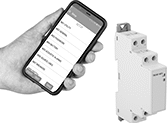

Whether installed in an electrical cabinet or hard-to-reach area, these timer relays are controlled remotely from your smartphone. They connect to your phone via a free downloadable app with NFC (Near Field Communication), so you can set time delay ranges, adjust settings, and save programs. An LED indicator on the relay shows that your switch is on and whether it’s actuated. Mount them directly to 35 mm DIN rail (also known as DIN 3 rail).
Although these relays have 30 different functions, they all fall into 11 categories. Within these categories, you can select different functions to allow you to add a switch, program a delay, or change how the relay responds to a trigger (turning on or off, pausing, or resetting).
Manual Switch Control—Use these functions to turn the relay on and off with a switch.
Fixed On/Off—The on function keeps the relay on whenever input voltage is applied; it will only turn off if the voltage is removed. The off function keeps the relay in an off state, even if input voltage is applied.
Switch-On (Single-Shot)—These functions require a switch to activate the relay, which stays on for the programmed amount of time. For example, lights in a storage room are turned on with a switch and stay on for a set time before turning off.
Delayed Start (Delay-on-Make)—These functions allow you to set how long it takes for the relay to turn on after input voltage is applied. For example, a drill starts pumping lubricant immediately, but it does not start rotating until the set time has elapsed.
Delayed Switch-Off (Delay-on-Break)—These functions use a switch instead of input voltage. When the switch is turned off, the relay remains on for a programmed amount of time before turning off. For example, a projector’s light is turned off with a switch, but its cooling fan continues to run for a set time.
Delayed Switch-On with Delayed Switch-Off—This function uses a switch instead of an input voltage. It allows you to set how long it takes the relay to turn on after a switch is turned on, and how long it will stay on after the switch is turned off. For example, a furnace turns on, but the fan doesn’t start pushing air through the vents until it has been heated. When the furnace turns off, the fan keeps blowing to circulate all the hot air.
Interval—These functions use input voltage to turn on the relay for a programmed amount of time. For example, when a part moving down a conveyor reaches a certain location, a cleaning spray comes on for a set amount of time.
Repeat Cycle—These functions start with an on cycle and then alternate between an on cycle and off cycle of equal durations until input voltage is removed, such as with a flashing light.
Asymmetrical Repeat Cycle—These functions start with an on-cycle and then have an off-cycle, but these cycles have different durations. The cycles repeat until input voltage is removed. For example, a sprinkler system sprays in short bursts followed by longer rest periods, on and off until input voltage is removed.
Switch-On Asymmetrical Repeat Cycle—These functions require a switch to activate the timing function. The input voltage is applied the whole time, and when you turn the switch on, the relay begins with an on-cycle followed by an off-cycle. These cycles have different durations, and they repeat until you turn the switch off. They could be used to turn on a motor or other system for a short period and then turn it off for a longer rest period, repeating that pattern until the switch is turned off.
Star-to-Delta—These functions allow you to set the time delay within the relay's range to switch contacts on a three-phase motor from star to delta configuration. Since star configuration takes less voltage to start than delta, these functions prevent voltage dips that often happen when a motor starts and are gentler on mechanical parts.
For technical drawings and 3-D models, click on a part number.
| No. of Terminals | Input Voltage | Control Power, W | Timer Relay Function | O'all Timing Range | Switching Current @ 240V AC | Max. Switching Voltage | Ht. | Wd. | Dp. | Operating System Compatibility | Features | Each | |
1 Circuit Controlled with 1 Off (Normally Open) or 1 On (Normally Closed)—SPDT | |||||||||||||
|---|---|---|---|---|---|---|---|---|---|---|---|---|---|
| 8 | 12V AC, 24V AC, 48V AC, 120V AC, 240V AC, 12V DC, 24V DC, 48V DC, 60V DC, 120V DC, 240V DC | 0.15 | Manual Switch Control Fixed On/Off Switch-On (Single-Shot) Delayed Start (Delay-on-Make) Delayed Switch-Off (Delay-on-Break) Delayed Switch-On with Delayed Switch-Off Interval Repeat Cycle Asymmetrical Repeat Cycle Switch-On Asymmetrical Repeat Cycle | 0.1 sec.-999 days | 8A | 250V AC | 4.1" | 0.7" | 2.5" | Android 5.0 or Later, iOS 14.4 or Later | LED Indicator | 0000000 | 000000 |
2 Circuits Controlled with 2 Off (Normally Open) or 2 On (Normally Closed)—DPDT | |||||||||||||
| 9 | 24V AC, 48V AC, 120V AC, 240V AC, 24V DC, 48V DC, 60V DC, 120V DC, 240V DC | 0.6 | Manual Switch Control Fixed On/Off Switch-On (Single-Shot) Delayed Start (Delay-on-Make) Delayed Switch-Off (Delay-on-Break) Delayed Switch-On with Delayed Switch-Off Interval Repeat Cycle Asymmetrical Repeat Cycle Switch-On Asymmetrical Repeat Cycle Star-to-Delta | 0.1 sec.-999 hrs. | 8A | 250V AC | 3.5" | 0.9" | 2.9" | Android 4.4 or Later, iOS 14.5 or Later | LED Indicator | 0000000 | 00000 |
Two-Hand Safety Switches
It takes two hands to activate these switches, minimizing the risk of accidental equipment start up. They have an emergency stop push-button to immediately cut power. They’re rated IP65 for protection from low-pressure washdowns.
Switches with push-button actuators require a safety relay (sold separately) for a complete system.
For technical drawings and 3-D models, click on a part number.

Actuator | Mounting | ||||||||||||||
|---|---|---|---|---|---|---|---|---|---|---|---|---|---|---|---|
| No. of Circuits Controlled | Switch Starting Position | Switch Action | Industry Designation | Material | Color | Switching Current @ Voltage | Ht. | Wd. | Dp. | No. of Holes | Hole Dia. | Mounting Fasteners Included | Features | Each | |
Push-Button Actuators | |||||||||||||||
| 2 | 1 Off (Normally Open) and 1 On (Normally Closed) | Springs Back (Momentary) | DPST-1NO/1NC | Plastic | Black | 8 A @ 250 V AC, 5 A @ 24 V DC | 7 5/16" | 18 1/2" | 5 7/16" | 2 | 29/64" | No | Emergency Stop Button | 00000000 | 0000000 |

| Input Voltage | No. of Terminals | Switching Current @ Voltage | For DIN Rail Ht., mm | Wire Connection Type | Features | Each | |
2 Circuits Contolled with 1 Off (Normally Open) and 1 On (Normally Closed)—DPST-1NO/1NC | |||||||
|---|---|---|---|---|---|---|---|
| 24V DC | 12 | 5.5 A @ 24 V DC | 35 | Screw Terminals | Self-Monitoring Circuitry | 00000000 | 0000000 |
Compact Programmable Logic Controllers
Smaller than other PLCs, these controllers save space in your control cabinet. They combine the functionality of a relay, timer relay, and switch in one unit, so you can program simple automation jobs. All have two types of delayed start (delay-on-make) and two types of delayed switch-off (delay-on-break) timing functions. They have passed strict U.S. and Canadian safety standards, and they’re IP20, which prevents fingers and other objects from making contact with live circuits. Mount them to a 35-mm DIN rail.
Controllers with a display make it easy to monitor or modify your system directly on the unit. Controllers without a display eliminate the risk of accidental adjustments while toggling through information or tampering by unauthorized users.
Program these controllers by connecting them to a computer and installing the required software (sold separately). After the initial programming, these controllers can be updated remotely by a human-machine interface (HMI) or computer.
For technical drawings and 3-D models, click on a part number.


Digital Inputs | Digital Outputs | ||||||||||
|---|---|---|---|---|---|---|---|---|---|---|---|
| Input Signal Type | Voltage | No. of | Voltage | Current | No. of | Signal Type | Operating Voltage | Communication Protocol | Software Included | Each | |
Controllers with Display | |||||||||||
Eaton Easy E4 Series | |||||||||||
| __ | 100-240V AC 100-240V DC | 8 | 240V AC | 8A | 4 | Relay | 100-240V AC 100-240V DC | Modbus TCP/IP | No | 000000 | 0000000 |
| Digital, Analog | 12V DC 24V AC 24V DC 0-10V DC | 8 (4 can be analog) | 240V AC | 8A | 4 | Relay | 12V DC 24V AC 24V DC | Modbus TCP/IP | No | 000000 | 000000 |
Controllers without Display | |||||||||||
Eaton Easy E4 Series | |||||||||||
| __ | 100-240V AC 100-240V DC | 8 | 240V AC | 8A | 4 | Relay | 100-240V AC 100-240V DC | Modbus TCP/IP | No | 0000000 | 000000 |
| Digital, Analog | 12V DC 24V AC 24V DC 0-10V DC | 8 (4 can be analog) | 240V AC | 8A | 4 | Relay | 12V DC 24V AC 24V DC | Modbus TCP/IP | No | 0000000 | 000000 |
| Manufacturer Model Number | For Operating System | Media Type | Each | |
For Eaton Easy E4 Series | ||||
|---|---|---|---|---|
| EASYSOFT-SWLIC/EasySoft 7 | Windows 7, Windows 8, Windows 8.1, Windows 10 | Download | 000000 | 000000 |
